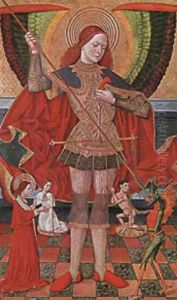Abadia Juan De La Paintings
Juan de la Abadía, also known as Juan de la Abadía el Viejo (the Elder) to distinguish him from his son, was a Spanish painter active during the late 16th century in the regions of Aragon and Catalonia. He was born in 1545, in the historical region of Huesca, which is now part of modern Spain. His work is characterized by the influence of the Aragonese and Catalan Gothic painting traditions, as well as the early Renaissance styles that were becoming prevalent during his time.
Abadía's art mainly focused on religious subjects, with a particular emphasis on altarpieces and panel paintings designed for local churches and cathedrals. His style is noted for its vivid coloration and the detail of its iconography, which was common in Spanish religious art of that period. Although he was influenced by the Italian Renaissance, his work retains a certain medieval quality in its formal approach and iconography.
Juan de la Abadía el Viejo's most significant contributions to the art world were his collaborations with his son, Juan de la Abadía el Joven (the Younger). Together, they created numerous works, which makes it sometimes difficult to distinguish between the individual styles and contributions of the father and son. This partnership was a common practice among artists of the time, where artistic skills and workshops were often passed down through generations.
Little is known about Abadía's personal life or his training. However, his surviving works indicate that he was a well-established master of his craft by the time of his death in 1598. His legacy was continued by his son and their workshop, which maintained the Abadía style well into the 17th century. Today, Juan de la Abadía is remembered as an important figure in the development of Spanish Renaissance painting, and his works are still admired for their devotional intensity and historical value.
